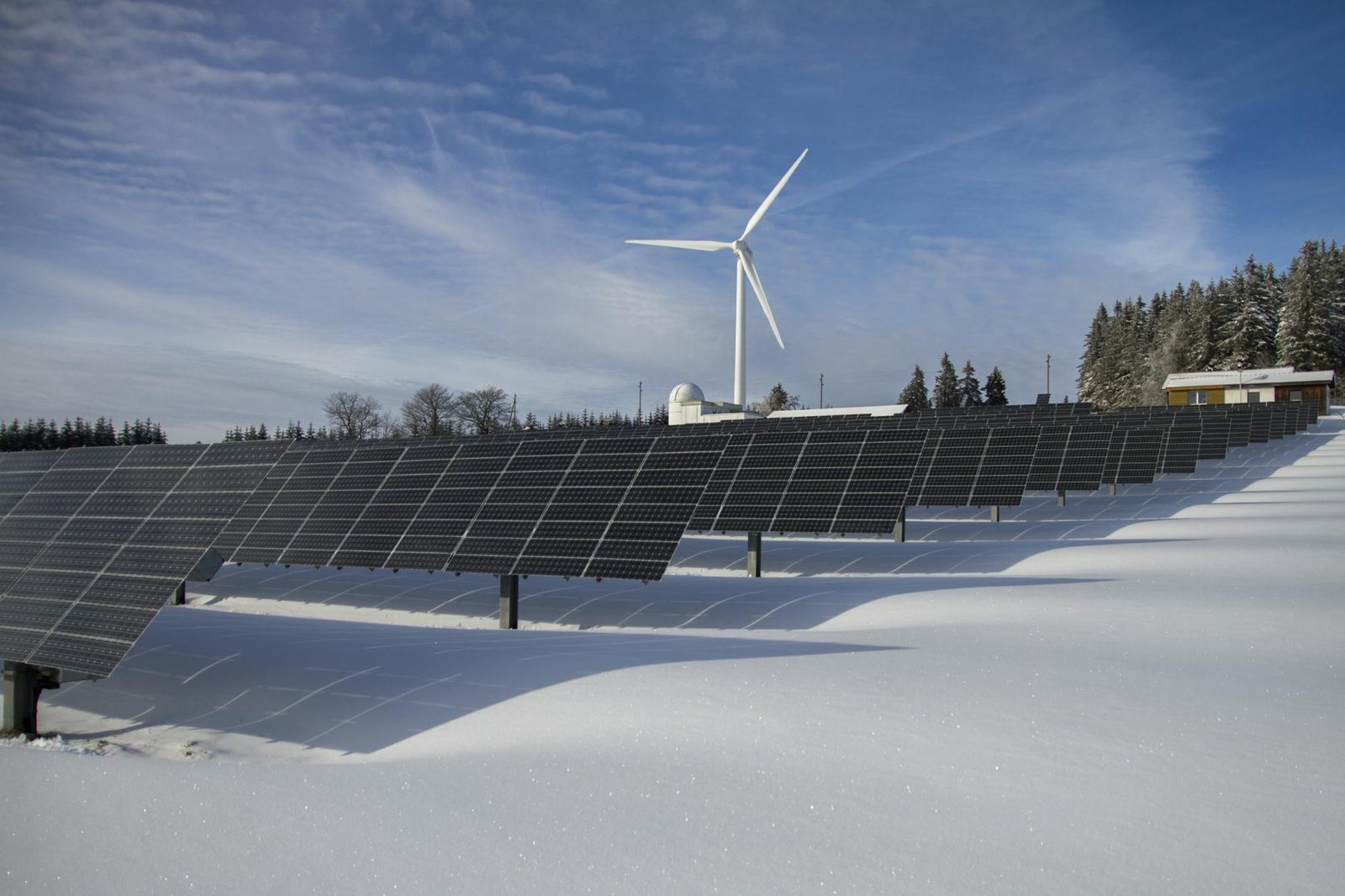Learn about renewable energy and its benefits for the environment and sustainability. Understand the differences between renewable and non-renewable energy sources, their availability, and environmental impact. Discover the economic opportunities and energy security that renewable energy offers. Explore the future of renewable energy and its potential to mitigate climate change. Invest in infrastructure, policy frameworks, and education to support the widespread adoption of renewable energy for a sustainable and resilient energy future.
Renewable Energy: A Sustainable Solution for the Future
It is a term that refers to energy sources that are naturally replenished or regenerated over a short period. These sources are considered sustainable because they can continuously provide energy without depleting finite resources or causing significant harm to the environment. Unlike non-renewable sources, which are finite and can be depleted, it offers a more sustainable and environmentally friendly alternative.
Renewable Energy: Definition and Importance
It refers to the power derived from natural sources that are continuously replenished. These sources, such as sunlight, wind, rain, tides, and geothermal heat, are abundant and inherently sustainable, as they naturally regenerate over brief periods. Unlike fossil fuels, which take millions of years to form and are at risk of depletion, they can provide endless power without the risk of running out.
Key Characteristics of Renewable Energy Include:
Sustainability:
Its sources do not deplete over time, making them a permanent fixture of our natural environment that can relied upon indefinitely.
Low Environmental Impact:
These sources generate energy in ways that produce significantly fewer greenhouse gas emissions than conventional fossil fuels, helping to reduce air pollution and combat climate change.
Availability:
From the vast windswept plains to sunny skies and flowing waterways, the forces that drive renewable energy found across the globe, making it accessible to most regions.
It offers a promising, viable alternative to fossil fuels, providing a pathway to energy independence, economic growth, and environmental sustainability, crucial to the health and prosperity of future generations.
Non-renewable energy refers to energy sources that cannot replenished within a human lifetime. These sources are finite and derived from materials that take millions of years to form, such as coal, oil, and natural gas. Once these resources consume, they are gone forever, making them unsustainable in the long term. Non-renewable energy sources know for their significant environmental impact, including the production of greenhouse gases and other pollutants that contribute to global warming and air pollution.
Differences Between Renewable and Non-Renewable Sources
The main difference between renewable and non-renewable energy sources lies in their availability and impact on the environment.
Availability:
Its sources, such as solar, wind, hydroelectric, and geothermal power, are abundant and widely available. They rely on natural processes that occur continuously, making them a reliable and sustainable source of energy for the future. In contrast, non-renewable sources, such as fossil fuels (coal, oil, and natural gas), are formed over millions of years and exist in limited quantities. Once these resources are depleted, they cannot be replenished within a human lifetime.
Environmental Impact:
Its sources have a significantly lower environmental impact compared to non-renewable sources. The production and use of non-renewable energy often result in harmful emissions, such as carbon dioxide and other greenhouse gases, contributing to climate change and air pollution. On the other hand, its sources produce little to no greenhouse gas emissions during operation, making them cleaner and more sustainable for the environment.
The Benefits of Renewable Energy
It offers numerous benefits, making it an attractive alternative to non-renewable sources. These benefits include:
1. Environmental Sustainability:
Its sources have a minimal impact on the environment. They produce little to no greenhouse gas emissions, reduce air pollution, and help combat climate change. By transitioning to renewable energy, we can reduce our reliance on fossil fuels and work towards a more sustainable future.
2. Energy Security:
Unlike non-renewable sources, often imported and subject to price volatility, its sources can be harnessed locally, reducing dependence on foreign energy sources. This enhances energy security and reduces the risk of supply disruptions.
3. Economic Opportunities:
It sector offers significant economic opportunities. Investing in renewable energy technologies can create jobs, stimulate economic growth, and attract investment. As the demand for renewable energy increases, so does the need for skilled workers in various sectors, such as manufacturing, installation, and maintenance.
4. Energy Independence:
By harnessing renewable energy sources, countries can reduce their dependence on imported fossil fuels. This enhances energy independence and reduces vulnerability to geopolitical tensions and price fluctuations in the global energy market.
5. Diversification of Energy Sources:
Transitioning to renewable energy allows for a more diverse energy mix. By incorporating various renewable sources, such as solar, wind, hydroelectric, and geothermal power, countries can reduce the risks associated with relying heavily on a single energy source. This diversification increases energy resilience and stability.
The Future of Renewable Energy
The future of renewable energy looks promising. As technology advances and economies of scale improve, its sources are becoming increasingly cost-effective and efficient. Governments, businesses, and individuals around the world are recognizing the importance of transitioning to renewable energy to mitigate climate change and promote sustainable development.
Investments in renewable energy research and development are driving innovation and driving down costs. This has led to significant growth in renewable energy capacity globally. According to the International Renewable Energy Agency (IRENA), the share of renewable energy in global power generation expected to increase from 26% in 2018 to 45% by 2050.
As we continue to embrace renewable energy, it is crucial to invest in infrastructure, policy frameworks, and education to support its widespread adoption. By prioritizing renewable energy, we can create a more sustainable and resilient energy future for generations to come.
Advantages and Disadvantages of Renewable Energy
Its technologies provide a sustainable way to generate power while offering numerous environmental, economic, and social benefits. Like any source of power, however, they also come with their own set of challenges. Below, we explore both the advantages and disadvantages of renewable energy sources.
Advantages
- Environmental Impact: Renewable sources such as wind, solar, and hydro produce significantly fewer pollutants including greenhouse gases. This helps in combating climate change and reducing air and water pollution.
- Renewable Nature: Unlike fossil fuels, sources are not finite and are replenished naturally. This sustainable aspect affords a limitless nature that prevents the depletion of natural resources.
- Energy Security: By investing in local energy generation from renewable sources, countries can reduce their dependence on imported fuels, improving their energy security and stability.
- Economic Development: The renewable energy sector is labor-intensive, which creates jobs in installation, maintenance, and more. This not only boosts the local economy but also contributes to a decrease in unemployment rates.
- Cost-Effectiveness: While the initial setup costs can be high, operational costs are often lower than those of traditional energy forms. Additionally, as technology advances, the cost of renewable technologies continues to drop, making them more accessible.
Disadvantages
- Intermittency: Some energy sources, like solar and wind, depend on the weather, which can be unpredictable. This makes energy supply less consistent and reliable unless supplemented with storage solutions or other forms of energy.
- High Initial Costs: The upfront costs for setting up renewable energy installations can be significantly higher than conventional power plants. This includes the cost of solar panels, wind turbines, and infrastructure for capturing and storing the energy.
- Land Use: Certain types of renewable energy sources, notably wind farms and hydroelectric plants can require a large amount of space. This could lead to land use conflicts and environmental degradation if not managed correctly.
- Storage Costs: Storing energy for use when renewables aren’t producing energy — during nighttime for solar or calm days for wind farms — requires energy storage systems, which can be expensive and technologically challenging.
- Technology Development: While advancements are being made, some renewable technologies are not able to fully compete with the energy output and efficiency of fossil fuels. Further research and development needed to overcome these barriers.
Moving Forward with Renewables
While there are challenges associated with renewable energy, the long-term benefits they offer in terms of sustainability, security, and economic growth make them essential to the future of global energy. Nations around the world are actively working to address these disadvantages through technological innovation, policy framework adjustments, and supportive economic measures to encourage the adoption of renewable resources. These efforts are crucial in paving the way towards a more sustainable and resilient energy future.
Renewable Energy Examples
It encompasses a variety of sources that harness natural processes to generate energy. Here are some key examples of renewable energy sources:
1. Solar Power
Solar energy captured through solar panels and photovoltaic cells that convert sunlight directly into electricity. It’s widely used in residential, commercial, and industrial settings.
2. Wind Power
Wind turbines use wind energy to generate electricity. Also, Wind farms can found both onshore and offshore and are particularly effective in areas with high wind speeds.
3. Hydroelectric Energy
This type of energy generated by the movement of water. Typically, hydroelectric power comes from water stored in dams that, when released, spin turbines to produce electricity.
4. Geothermal Energy
Geothermal power utilizes the heat from the Earth’s core to generate electricity. It involves tapping into hot water and steam reservoirs beneath the Earth’s surface to power turbines.
5. Biomass
Biomass energy involves using organic materials like plant and animal waste. These materials burned or biochemically converted to produce heat or electricity.
6. Tidal Power
Tidal energy harnesses the energy from tidal flows to turn turbines or generate electricity. Although less common, it is a promising energy source due to the predictable nature of tides.
7. Wave Energy
Wave power converts the energy from surface waves on oceans or lakes into electricity, using various technologies that capture the movement of the water.
These renewable energy sources play a crucial role in reducing dependence on fossil fuels, promoting environmental sustainability, and enhancing energy security.






Leave a Reply